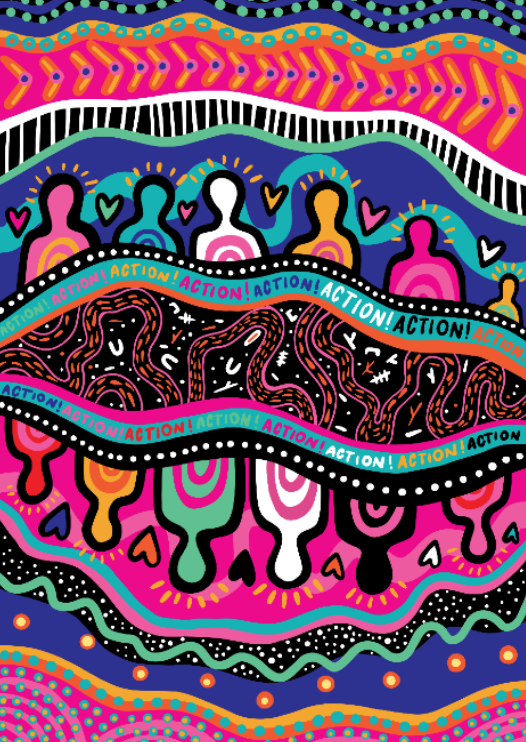Reconciliation Week: Jessamy Gleeson writes about steps towards allyship
This week, many of us have been focused on coping with being thrown back into lockdown. However, it’s also held some special significance for those of us reflecting on the 20th anniversary of National Reconciliation Week. In the middle of attending many (virtual) events, it struck me that this week has been all about trying to connect back with the Country I’m on through my actions: long walks, runs, and bike rides outside. Part of it has been trying to shake off the lockdown blues, but part of it’s also been an attempt to centre myself in the midst of the upheaval of lockdown.
NRW2021 Artwork: Action by Jessica Johnson, is the story of the land and community sharing the united call for action on reconciliation.
National Reconciliation week has now been around for 20 years – that’s over two decades of well-intentioned awareness raising. But I still see many gaps in people’s knowledges when understanding the history of the Country we are located on. A key reason for these gaps is what we often refer to as ‘the Great Australian Silence’ – a term coined by W.E.H. Stanner in 1968 that refers to the many holes in our collective understanding of what makes up our history. Stanner refers to this as a “cult of forgetfulness” – we don’t want to know the ugly truth of colonisation, and so we do not speak of it. If you’ve ever asked the question, “why weren’t we taught about this in school?”, the Great Australian Silence is probably the answer. Our schools, our universities, our cultural and legal institutions are still practitioners of this silence: one secondary school text book was still asserting that Aboriginal peoples were hunter-gatherers right up until 2012. The truth is much more complex: we were farmers, bakers, preservers, cultivators and much more. But to acknowledge something like this would mean recognising the true impacts of colonisation: the loss of culture, language, and Country.
One of the ways I’ve been spending this last week in lockdown is through connecting to the Country I’m on. This year’s theme for National Reconciliation Week is ‘More than a word: Reconciliation takes action’. Ironically, for those of us in lockdown we don’t have as much in the way of actions at the moment; we’re restricted in how and where we can participate, and show our support. But in the spirit of individual actions, I wanted to outline a few small ways we can each take the time to learn, and action, some steps towards allyship:
Learn the names of the Country you’re on, and encourage others to do the same through an Acknowledgement of Country
Do you know the names for the Country you’re on? If you don’t, AIATSIS have a great map you can use to learn a little more about where you’re from. One of the good things to know in looking at this map is that it isn’t precise – and that’s because our histories and stories have, in many cases, been obscured through the process of colonisation. These borders and boundaries aren’t exact, and the map itself shows general locations.
Once you know a bit more about the name and history of Country you’re on, make sure you use this name in a formal Acknowledgements of Country for any events you’re partaking in – and while you’re at it, check your understanding of the difference between an Acknowledgement of Country, and a Welcome to Country. A Welcome to Country is a privilege, and it’s not something just anyone can do – if I had a dollar for every time I was asked to do a Welcome for a place I’m not from, I’d have…well, $15, probably.
Understand the histories of care that have been practiced on Country
There’s an excellent overview of the history of Indigenous agriculture provided through the ABC radio show, ‘Bush Telegraph’. This one-off special, called ‘Rethinking Indigenous Australia’s agricultural past’, includes an interview with Bruce Pascoe and Bill Gammage on the history of care for Country.
Take the time to listen to the podcast – but make sure you step away from your screen or device to do so. If you can, get outside in the fresh air; go for a walk, and use the space and time to appreciate and understand more clearly the deep history of the land you are on. You can listen to the podcast recording here.
Listen, listen, listen – and then act
The best way to stuff something up, and step on some toes? Not listening before you act. A lot of us are asked, “but what can I actually do to help?”. There are as many different answers to this as there are people who have asked the question. But one of the key responses is to privilege our voices and actions over your own. If you’re keen to do some reading of your own this week, then Summer May Findlay breaks down how to be a good ally in more detail over here. One of her key points? Knowing when your actions and voices are welcome, and when it’s time to be quiet.
If you’re interested in reading more about when and how you can speak up and take action, then the Reconciliation Week website has put together a brilliant list of ‘20 actions for Reconciliation’. Importantly, the list also highlights one of the biggest obstacles of events like this one: that people tend to shut up, and pack up, at the end of the week. No true forms of change will be achieved if we only spend one week a year talking about reconciliation: it’s a job for all of us, all the time. So, my final challenge to you in understanding how to ‘action’ something for National Reconciliation Week? Take it beyond this week alone – your actions should be all year around, not just when the spotlight’s shining brightest.
Article by Jessamy Gleeson

